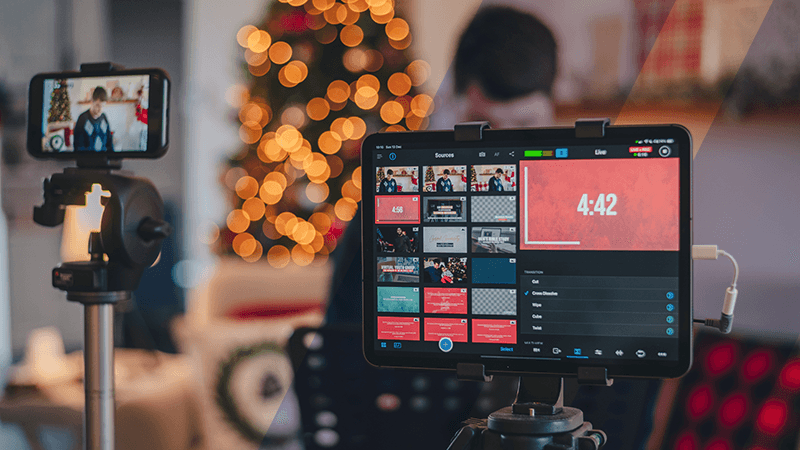It’s a well-known fact that video marketing is the new king of content. With the human attention span declining sharply over the years, it’s evident that brands are now focusing more on creating different types of marketing videos to capture attention and increase engagement.
However, social media platforms these days are overstuffed with video content for marketing that doesn’t convert. The root cause of this dilemma — brands jumping on various video marketing ideas without understanding the intent of their marketing videos.
In this blog article, we will walk you through different types of marketing videos proven to increase your online presence, which in turn drives revenue for your business. By the end of this article, you’ll learn what is suitable for your target audience and what to implement next for your video marketing strategy.
Different Types of Marketing Videos to Power Your Video Marketing Strategy
There’s no such thing as ‘one-size-fits-all’ video content. Every marketing video is specifically designed for a prospect with unique needs. Getting the perfect video in front of your customers is the key to seeing ROI in your video marketing strategy. If you want to start leveraging the power of video marketing, below are some of the different types of video marketing content and video marketing examples you can take inspiration from:
1. Product demos
A product demo video demonstrates the functionality of your product so that viewers can picture what using the actual product will be like. Industries like electronics and automotive utilize this type of marketing video to highlight the benefits of their products.
Back in the days when online videos were not all the rage, product demos were used in grocery stores, shopping malls, and trade shows. Now that marketing has shifted online, product demo videos have become a staple part of anyone’s B2C marketing strategy.
Nowadays, including product demo videos on your business’ website and social media platforms is crucial. By watching a brand’s video, 84% of consumers claim they have decided to buy a good or service. Moreover, almost half of internet users search for different types of product videos before purchasing.
If you want to build awareness among potential customers, you can bank on product demos. It does an excellent job of explaining your product’s main features and benefits. Not only does it spark interest, but it can also separate your brand from your competition. When a prospect understands how your product works, they are more likely to convert, which leads to improved sales.
When creating a product demo video, consider the four essential elements: an overview of your product, the solution your product offers, how your product works, and a call to action. Also, most online shoppers will watch a product demo video if it is under two minutes long, so keep it short and sweet.
Example of a great product demo video
2. Promotional video
A promotional video is a type of marketing video that promotes a product or service to both potential and existing customers. Businesses of all kinds can use this video in multiple ways. Videos about seasonal greetings, celebrating milestones, or sharing a brand’s story are some types of promotional videos.
While product demos center around the product’s functionality, the power of a promo video may seem quite extensive. The benefits of your product, why it’s the most excellent option for customers, how it will improve their lives, how much it costs, and where to get it may all be demonstrated in a promotional video.
Ultimately, the goal of a promo video is to sell a product or service. However, it’s done subtly by inspiring and educating people so they can move down your sales funnel.
According to Optinmonster, 84% of users purchased a product or service after watching a promotional video from a brand. So, a promo video is a perfect way to introduce your company on your website, YouTube channel, Facebook page, or any other digital marketing platform.
Similar to product demos, a great promo video should encapsulate your customers’ problems, proposed solutions, unique value propositions, and call-to-action. It’s important to weave these elements together to create a long-lasting impression on the viewers. In terms of length, a promo video should last no more than two minutes.
Example of a great promotional video
3. Company culture video
People who are interested in your organization may want to learn more about your company culture. Indeed, they want to see how things get done around the workplace. And also, how your employees feel about what they do. Instead of pinning a lengthy social media post about your company culture (which people don’t bother to read), why don’t you use a company culture video?
A company culture video explains what your brand is all about, who the people behind it are, and what you stand for. Aside from marketing a brand as a whole, it is also used in attracting job seekers and building B2B relationships. For instance, a potential hire may want to work in your company by seeing the company benefits from your marketing video.
The content of a company culture video may vary depending on the goal and the format you want to use. But the best corporate culture videos use employee testimonials, office tours, workplace activities, CSR, or combinations of these.
There are tons of moving pieces to consider when crafting a compelling company culture video. It’s up to you how you will personalize it but don’t forget the crucial elements: brand story, unique value proposition, and your main highlight. You’ll put a lot of emphasis on your employees, for example, if your video is about your dedication to your team. Talking to and about team members should make up most of your video.
Another significant factor to take into account is the duration of your video. Nobody wants to view a video about a company for more than ten minutes. A length of between 1:30 seconds and 3 minutes would be ideal. So keep it brief and aim to keep it under four minutes.
Example of a great company culture video
4. Testimonials
Did you know that a video testimonial from a previous customer would increase the likelihood of purchase for 2 out of 3 customers? When consumers shop online, they seek information that will reassure them before making a purchase; video testimonials are excellent at doing this.
Video testimonials feature satisfied customers who speak about the value they obtained from a product or service. It is a very effective marketing tactic that boosts website conversions and establishes credibility and trust. B2B companies in retail, electronics, and SaaS often leverage it to attract more customers.
The strength of social proof combined with an entertaining medium like video makes testimonial videos so powerful. Of course, anyone may create a blurb promoting their product, capture a photo of an unknown person, and combine the two. But having someone connect their name and face to your brand that’s hard to make up.
When creating video testimonials, it’s important to piece together essential elements like customer introduction, pain points, product usage, and tangible results. However, finding the right advocate for your testimonial may not sound easy. That’s why starting with customers you already have a strong relationship with is recommended.
An excellent video testimonial can typically convey your message in less than two minutes. In fact, aiming for 1:30 to 1:45 is even more effective. It might not seem like enough time, but keep in mind that viewers don’t have much patience for long-form video content.
Example of a great video testimonial
5. Explainer videos
Imagine you have installed a mobile wallet app to transfer some cash to your bank account. However, upon navigating through the app, many features baffle you. As a result, you deleted the app and looked for another workaround. See? This is how a customer feels when they don’t understand the functionality of your product. To address this, you may need the help of explainer videos.
An explainer video is a type of marketing video that provides in-depth explanations of how a product or service works and how it benefits end users. Much of its content focuses on delivering procedures to complete an action for a frictionless customer experience.
Computer software companies, for example, use 90-second explainer videos to teach end-users how their apps work and how it solves their biggest pain points. Finance, healthcare, manufacturing, and blockchain are also some of the industries that need explainer videos.
Compared to other types of marketing videos, explainer videos fulfill their purpose without being sales-y. It’s because it focuses more on educating while entertaining users through visuals. Also, it fits anywhere on all your online platforms. You can display it on your landing pages, social media channels, and even at corporate events and expect to drive conversions on autopilot. Also, it is shareable online and can stay relevant over a long period of time.
There are different types of explainer videos you can consider. One of which is an animated video that is perfect for explaining intangible tech products like software. Regardless of your preferred format, two elements should be your utmost priority: engaging visuals and professional voiceover.
The success rate of an explainer video lies in your script. So make sure it is concise, straightforward, and covers important details such as the problem, solution, how it works, and call-to-action. Most importantly, its average video length should be no more than two minutes.
Example of a great explainer video
6. Sales pitch
Since the pandemic restricted physical movements, most sales presentations lately have adopted the medium of video. As a result, salespeople no longer have to reserve a venue to pitch to a client. Recently, many have been sending sales pitch videos over email, and surprisingly, the result is way better than before!
A sales pitch in video format is a streamlined sales presentation that outlines the overview and benefits of a company, product, or service. Sales representatives often send it to prospective clients to close a deal or secure a partnership.
One of the advantages of sales pitch videos is that it requires less time to make than traditional presentations. In face-to-face presentations, you need to set up a lot of equipment to start hitting the ground running. Unlike in sales pitch videos, all you need is a good script, a camera, and a reliable editor for your video post-production.
Keep it concise when creating a high-converting sales pitch video, and avoid being too salesy. Only include relevant information such as your client’s pain points, key benefits of your product/service, and a powerful CTA. Also, don’t forget to add testimonials or case studies to support your sales pitch. Above all, keep your sales pitch video under 3 minutes only.
Example of a great sales pitch video
7. Behind-the-scenes videos
Are you running out of content to show to your audience? Why don’t you let them peek behind the curtain of your business through behind-the-scenes videos?
Behind-the-scenes (BTS) videos are a type of marketing video that show your fans what goes on behind the scenes of the brand they adore, such as the corporate culture, staff, and daily operations of the company. It is effective marketing content because it allows brands to show transparency with their customers and earn their trust.
BTS video marketing examples might include chefs preparing food in a restaurant or café or a time-lapse video of an event being set up. BTS videos are easy to produce, especially if you choose to go live. Also, it’s suitable for social media viewing because it’s fun and engaging.
Although it’s easy to create, there are also things to consider in putting together an awesome BTS video. For instance, avoid displaying anything that can damage your brand reputation. In addition, specific causes could discourage your audience, including unkempt workstations, unhealthy work environments, and hostile encounters with coworkers.
Since BTS videos are usually live, you may not consider how long they should be. But make sure you have a checklist of things you should and shouldn’t do. Also, tailor your content to the platform of your choice.
Example of a great behind-the-scenes video
8. User-generated videos
If you don’t want to spend a lot of money on marketing, there’s a cost-effective way for you to promote your brand without breaking a sweat. Do you want to showcase why your loyal customers love your brand? Then, use user-generated content (UGC) to provide social proof!
A UGC video is a type of marketing video produced by a customer or your brand loyalists not affiliated with your brand. The content might be in the form of a review, a social media update, or even tutorials. Brands with huge followers often use this to help influence engagement and increase conversions.
When a customer posts a short video on their IG stories after visiting your store, you can repost it and share it with your followers. By doing so, you’re sending a message to everyone that your store is open and happy to accept more customers. Moreover, you can also include offers like discounts on your post to attract more visitors.
So what makes UGC videos effective? Well, this type of marketing video is more honest, personal, and trustworthy than any type of branded video. In fact, almost half (47%) of millennials and 36% of baby boomers trust UGC videos more than branded content.
Customers want a more enjoyable shopping experience and rely on other customers to provide product information and advice on recent purchases. When a prospect sees that a fellow customer is delighted by a product, it increases their shopping confidence and makes them check out what the hype is all about.
Example of a great UGC video
9. Webinars
It may not be as creative as other marketing videos, but webinars are gaining popularity these days. Do you want to promote your brand while providing value to your prospects? Then, launching a webinar could be a smart move.
A webinar is a real-time, online event that uses telecommunications technology broadcast over the internet. It has long been used as a meeting platform that includes audio-visual contact between a speaker and attendees. But nowadays, it is also used to generate leads, increase brand recognition, and cultivate relationships with potential customers.
Businesses are capitalizing on the greater content generation of webinars. The best thing about webinars is that they can be recorded, edited, and then used to create new content. So you could upload snippets from your webinar, for instance, to your Instagram stories. Perhaps you could also upload the whole seminar to YouTube.
There are plenty of ways to increase your conversion through webinars. For instance, you can use a webinar to show your leads any new features your business has added to your product. Like in a demo or training session, your leads could ask questions throughout your webinar. In this way, you’re not just educating your potential customers. You’re also providing value-added services that may help them convert into buying customers.
Example of a great webinar
10. PSAs
When a particular social issue sparks debates online, it’s normal to see brands turning a blind eye. But is it good for a brand to stay silent about conversations that affect its customers?
A 2020 study from Kantar revealed that 54% of consumers now expect brands to participate actively in social discussions about matters like #MeToo and racial injustices. Brands that engage in social issues are said to build a positive business reputation. Are you now planning to promote your brand while being clear about your values? Then, public service announcements (PSAs) could be your best partner!
A PSA is a brief educational video that aims to increase audience awareness of pressing subjects such as drug usage or drunk driving. Apart from raising awareness, its main objective is to inspire change. It presents actionable tips people may use to get out there and make a difference instead of enumerating all the reasons why a certain behavior is improper.
Back in the day, this type of marketing video was broadcasted only as a TV or radio commercial or as a print ad. However, with the emergence of social media, brands may now post their PSAs on platforms like YouTube, Facebook, or even on their websites.
Instead of solely promoting your brand, you can use PSAs to shed light on relevant issues like the current pandemic. For instance, you might create a PSA to inform the public about getting immunized against the coronavirus and nudge them into making an appointment for the shot.
Example of a great PSA video content
Enhance Your Marketing Videos by Prioritizing Customer Care Outsourcing
The journey to outstanding marketing videos begins with exceptional customer care. Outsourcing your customer care to ManilaPros is the first step in creating a marketing strategy that resonates with your audience. By ensuring your customer support is top-notch, you lay the groundwork for marketing content that truly connects.
At ManilaPros, we offer full-service, five-star customer care for retailers. We understand the power of customer experience in shaping brand perception. Outsourcing your customer care to us means getting customer service agents that are vetted and certified for your brand.
Learn more about our customer care outsourcing services. Book a call with us today to get started.




